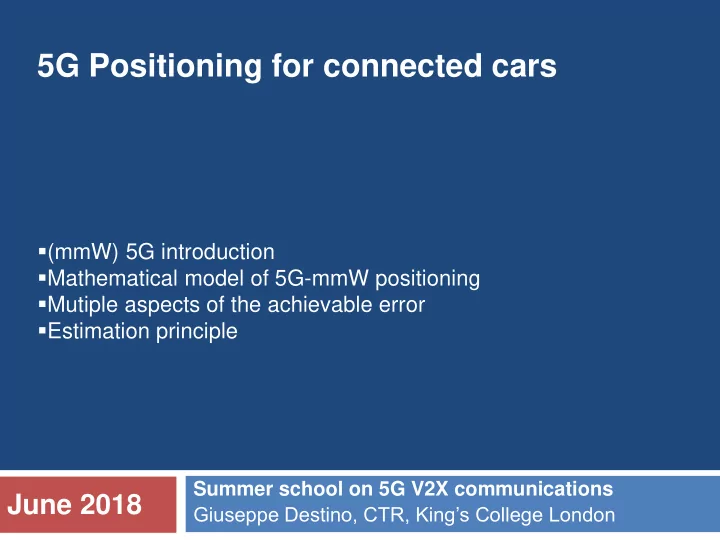

5G Positioning for connected cars ▪ (mmW) 5G introduction ▪ Mathematical model of 5G-mmW positioning ▪ Mutiple aspects of the achievable error ▪ Estimation principle Summer school on 5G V2X communications June 2018 Giuseppe Destino, CTR, King’s College London
5G vs LTE-A (4G) 5G New carrier frequencies (sub-6 GHz and mmW) Beam-based communication New radio-access procedures New communication models Location-awareness
Radio-frequency map 0.8 GHz 6 GHz 100 GHz Frequency 37-40 64-71 3.5-5 24-28 0.8-2.8 GHz GHz GHz GHz GHz 4G 5G 5G 5G 5G 10m 1m 200m 10Km Range Medium range Very-short Wide range uRLLC Com eMBB mMTC
mmW sparse channel model (Physical) Representation with 4 physical dimensions Sparse due to high carrier frequency
5G positioning: what is new Single BTS approach Use channel sparsity Use direction and distance infromation jointly Use a geomteric model to exploit one-bounce link
Positioning technology landscape Availability Satellite remote positioning rural A-GNSS CI / E-CID sub- (GPS, GLONASS, …) urban based methods city WiFi in-door BLE/UWB Accuracy 1m 3 10 50 100 300 1km 3km 10km
5G Positioning: mathematical model Estimate location and rotation of the MS Location-based channel parameterisation
When can we do positioning Positioning using beam sweeping Positioning using reference signals https://www.keysight.com/upload/cmc_upload/All/Understanding_the_5G_NR_Physical_Layer.pdf Inital access Sweeping multiple directions allows channel discovery No overhead (or reduced is specific pilots are needed) Periodically to allow location tracking Benefit Location-awareness prior communications
Signalling for positioning DATA Beam Training DL UE collects and processes signals over multiple beams UL gNB collects and processes signals over multiple beams Received OFDM signal at the m-th RF chain
Analysis of the Position FIM More information by increasing the subcarrier spacing More information by using edge-band subcarriers Bearing information depends on the sensitivity of the beampattern in angle domain No derivations … AoA and AoD are coupled
Tool for performance analysis : CRLB FIM for channel parameters Apply variable transformation Compute the CRLB from the inverse of 𝐊 η G. Destino , H. Wymeersch, “On the Trade-off Between Positioning and Data Rate for mm- Wave Communication”, in IEEE International Conference on Communications Workshops, 2017
Position-rotation error bound DL mode LoS link provides 3 types of information AoA information: position-rotation dependent AoD information: position dependent Ranging: position dependent NLoS link provides a combined infromation AoA-Ranging information: position-scatter-rotation dependent The FIM of Position-Rotation in rank 3 in 2D, therefore position-rotation is feasible with 1 LOS + N >= 0 NLOS N >=3 NLOS R. Mendrzik , et All., “Harnessing NLOS Components for Position and Orientation Estimation in 5G mmWave MIMO”, arxiv 2017
Pilot signals Distributed Center-localised Edge-localised
Ranging error Scenario: AoA = 0 deg, AoD = 180 deg, d = 100m, 2 RF chains, 16 ULA
Ranging error 2 RF chains Impact of array gain Scenario: AoA = 0 deg, AoD = 180 deg, d = 100m, 2 RF chains, 16 ULA, orthogonal beams
Bearing error Due to the derivative of the beamforming Scenario: AoA = 0 deg, AoD = 180 deg, d = 100m, ULA, orthogonal beams
Achievable localisation error
Achievable localisation error
Requirements for 5G positioning AoA and AoD information Multiple beamforming to acquire information about AoA, AoD LOS / LOS and >1 NLOS / >= 3 NLOS Narrow beams for high SNR and high AoA/AoD resolution ’Spread’ pilots for high delay resolution
Sweeping strategy Hierarchical search Exhaustive search
Impact of beam training searching strategy Exhaustive search Information is acquired when main beam or sidebeam ”hit” the LOS ray Resource consuming Beam-codebook dependent Hierarchical search Infromation is acquired at each step of the search High accuracy can be achieved as beams point to the ”right” direction Time efficient
Trade-off: Rate vs Accuracy • Hierarchical search: more time efficient but more sensitive to noise • Exhaustive search: more robust to noise, trade-off between rate and positioning accuracy
Rate-PEB joint resource optimization User rate Time sharing optimisation
Position-estimation approach A. Shahmansoori, G. E. Garcia, G. Destino, G. Seco-Granados and H. Wymeersch, "Position and Orientation Estimation Through Millimeter-Wave MIMO in 5G Systems," in IEEE Transactions on Wireless Communications , vol. 17, no. 3, pp. 1822- 1835, March 2018
Structured sparsity Angular domain Subcarrier 1 Signals over multiple subcarriers share the same ”angular information” Signals over multiple Subcarrier 2 MIMO channels share the same ”time information” Subcarrier N
Two-step estimation in a nutshell Step1: Sparse estimation with common support Exploit common spatial-sparsity across carriers CS technique for common support model Estimate delay and channel gain per path Step2: Refinement of the channel parameters SAGE: per path refine the channel parameters using a successive cancellation method Step3: Non-linear mapping to location Solve non-linear least square problem
5G – GNSS hybrid solution Sat1 Sat2 ψ 1 ψ 2 BTS θ 1 θ 2 MS - θ 0 - α On going work !
Reading H. Wymeersch, G. Seco-Granados, G. Destino, D. Dardari and F. Tufvesson, " 5G mmWave 1. Positioning for Vehicular Networks ," in IEEE Wireless Communications , vol. 24, no. 6, pp. 80-86, Dec. 2017. A. Shahmansoori, G. E. Garcia, G. Destino, G. Seco-Granados and H. Wymeersch, " Position 2. and Orientation Estimation Through Millimeter-Wave MIMO in 5G Systems ," in IEEE Transactions on Wireless Communications , vol. 17, no. 3, pp. 1822-1835, March 2018 G. Destino and H. Wymeersch, " On the trade-off between positioning and data rate for 3. mm-wave communication ," 2017 IEEE International Conference on Communications Workshops (ICC Workshops) , Paris, 2017, pp. 797-802. J. Saloranta, G. Destino and H. Wymeersch, " Comparison of different beamtraining 4. strategies from a rate-positioning trade-off perspective ," 2017 European Conference on Networks and Communications (EuCNC) , Oulu, 2017, pp. 1-5. G. Destino , J. Saloranta, H. Wymeersch and G. S. Granados, “ Impact of Imperfect Beam 5. Alignment on the Rate-Positioning Trade-Off ”, 2018 IEEE Wireless Communications and Networking Conference (WCNC): Special Session Workshops
Recommend
More recommend